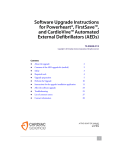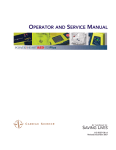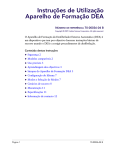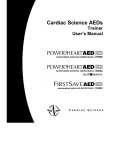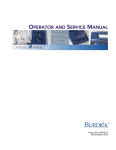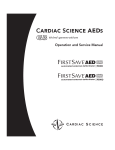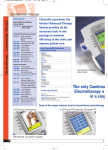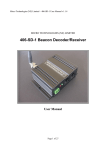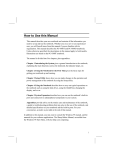Download Powerheart AED G3 Instructions for Use
Transcript
Instructions for Use WARNING: Electric Shock and Fire Hazard. Do not connect any telephones or unauthorized connectors to the socket on this equipment. CARDIAC SCIENCE AEDs INSTRUCTIONS FOR USE AED OVERVIEW Become familiar with the controls and how to use the AED properly before operating the product. CONTENTS: AED Overview Symbol Descriptions Safety Performance Standards How to Perform a Rescue Safety Terms and Definitions Safety Alert Descriptions STAR Biphasic Waveform Energy Levels and Patient Impedance Contact Information page 1 page 7 page 10 page 13 page 16 page 17 page 20 page 21 page 23 AED DESCRIPTION: The AED is a self-testing, battery-operated automated external defibrillator (AED). After applying the AED’s pads to the patient’s chest, the AED automatically analyzes the patient’s electrocardiogram (ECG) and advises the operator to push the button and deliver a shock if needed. For the Powerheart AED G3 Automatic, the AED automatically delivers a shock if needed. The AED guides the operator through the rescue using a combination of voice prompts and/or text, audible alerts, and visible indicators. Persons authorized to operate AEDs must have training in accordance to state, province or country regulations. 1 CARDIAC SCIENCE AEDs INSTRUCTIONS FOR USE PRODUCT MODELS This instruction manual is for multiple, unique Cardiac Science AED models. They share a basic set of features and differences are noted throughout the manual. The AED warranty for defects in materials or workmanship is 7 years from date of purchase. For the full warranty statement see the warranty paper packaged with your AED or refer to the Operation and Service manual on the Quick Start CD-ROM. 2 CARDIAC SCIENCE AEDs INSTRUCTIONS FOR USE RESCUEREADY® STATUS INDICATOR The RescueReady STATUS INDICATOR does not apply to AED 9300C. When this STATUS INDICATOR is GREEN, the AED is RescueReady. This indicates the AED self-tests have verified the following: • • • Battery has an adequate charge. Pads are properly connected and are functional. Integrity of the internal circuitry is good. When the STATUS INDICATOR is RED, check AED pads, battery and/or call customer service. 3 CARDIAC SCIENCE AEDs INSTRUCTIONS FOR USE INTELLISENSE® BATTERY INSTALLATION • • • • Insert battery as shown. Push firmly to snap into place. Open the lid for 5 seconds. The STATUS INDICATOR turns GREEN (Does not apply to 9300C). ABOUT THE INTELLISENSE BATTERY • When the last battery indicator (LED) is red, the battery is low. Replace the battery right away. • A new battery typically takes 10 seconds to charge the AED to maximum energy. • Output voltage: 12VDC (max) • Batteries are non-rechargeable • Lithium contents: 9.2g (max) • Check local regulations for disposal information MODEL FULL OPERATIONAL REPLACEMENT GUARANTEE (FROM DATE OF INSTALLATION) TYPICAL SHOCKS 9146 Lithium 4 Years up to 290 shocks 9143 Lithium 1 Year up to 100 shocks Additionally, batteries are warranted against defects in materials and workmanship for 7 years from date of purchase. 4 CARDIAC SCIENCE AEDs INSTRUCTIONS FOR USE PADS The pads are already installed in the AED when shipped to you. Confirm that that they are connected. Then, ensure that the expiration date is visible through the clear window of the lid. Make sure the STATUS INDICATOR is GREEN (does not apply to 9300C). ABOUT THE PADS • • • Self-adhesive, disposable pads Minimum combined surface area: 228cm2 Extended length of lead wire: 1.3m AUDIBLE MAINTENANCE INDICATOR For all Cardiac Science AEDs 9300 series: When the daily, weekly, or monthly self-test determines maintenance is required, an audible beep is sounded every 30 seconds until the lid is opened, or the battery power is depleted. Opening and closing the lid may deactivate the beep. If the next automatic self-test does not correct the error, the beep will be reactivated. 5 CARDIAC SCIENCE AEDs INSTRUCTIONS FOR USE AFTER A RESCUE ATTEMPT After transferring the patient to Advanced Life Support personnel, prepare the AED for the next rescue: 1. 2. 3. Retrieve the rescue data stored in the internal memory of the AED. Connect a new pair of pads to the AED. Close the lid. 4. Verify the STATUS INDICATOR on the AED handle is GREEN. (Does not apply to 9300C). 6 CARDIAC SCIENCE AEDs INSTRUCTIONS FOR USE SYMBOL DESCRIPTIONS The following symbols may appear in this instruction manual, on the AED, or on its optional components. Some of the symbols represent standards and compliances associated with the AED and its use. Dangerous Voltage: The defibrillator output has high voltage and can present a shock hazard. Please read and understand all safety alerts in this resource guide before attempting to operate the AED. Attention!: Identifies important information in this resource guide, on the AED, or on its component parts regarding the safe and proper use of the AED. Defibrillator Proof Type BF Equipment: The AED, when connected to the patient’s chest by the pads, can withstand the effects of an externally applied defibrillation shock. CE Mark: This equipment conforms to essential requirements of the Medical Device Directive 93/42/EEC. The AED is protected against the effects of splashing water in accordance with IEC 60529. Classified by ETL Semko with respect to electric shock, fire and mechanical hazards only in accordance with UL 60601-1, CAN/CSA C22.2 No.601.1-M90, EN60601-1 and EN60601-2-4. Conforms to UL Standard UL60601-1. Certified to CAN/CSA Standard C22.2 No. 601.1-M90. International symbol for ON. Open the lid to turn on the AED. Open the lid to turn ON the AED. Indicates the AED battery status. The illuminated areas indicate the remaining battery capacity. Check pads. The pads are missing, not connected or have compromised functionality. 7 CARDIAC SCIENCE AEDs INSTRUCTIONS FOR USE Indicates AED requires maintenance by authorized service personnel. When the SHOCK indicator is lit, push this button to deliver a defibrillation shock. When the CONTINUE indicator is lit, push this button to clear the internal memory to allow storage of new rescue data in the AED. (Only for models 9300E and 9300C not equipped with Multiple Rescue software) A red indicator with a BLACK X means the AED requires operator attention or maintenance, and is not RescueReady. (Does not apply to 9300C) A green indicator without a BLACK X means the AED is RescueReady. (Does not apply to 9300C) Use pads by this date. Date of manufacture, year and month. Date of factory recertification. Latex free. Disposable. Single patient use only. Tear here to open. Do not recharge battery. Position of pads on the chest of patient. For use by or on the order of a Physician, or persons licensed by state law. 8 CARDIAC SCIENCE AEDs INSTRUCTIONS FOR USE Dispose of properly in accordance with all state, province, and country regulations. Do not incinerate or expose to open flame. Explosion Hazard: Do not use in the presence of a flammable gas, including concentrated oxygen. Upper and lower temperature limits. Device model number, battery model number Lot number Lithium sulfur dioxide Serial communication port Additional information is provided in the AED Operation and Service Manual. Points to important information regarding the use of the AED. Lift here Manufacturer Authorized European Representative Symbol for the marking of electrical and electronic equipment that must be recycled. 9 CARDIAC SCIENCE AEDs INSTRUCTIONS FOR USE SAFETY PERFORMANCE STANDARDS DIMENSIONS Measurement Height Width Depth Dimension 8 cm (3.3 in) 27 cm (10.6 in) 31 cm (12.4 in) WEIGHT Model 9300 Weight with Batteries and Pads 3.10 kg (6.6 lb) ENVIRONMENTAL OPERATION AND STANDBY CONDITIONS Atmosphere Condition Temperature 0°C to 50°C (32°F to 122°F) Humidity 5% to 95% (non-condensing) Pressure 57kPa (+15,000ft) to 103kPa (-500ft) SHIPMENT AND TRANSPORT ENVIRONMENTAL CONDITIONS (for up to 1 week) Atmosphere Condition Temperature -30°C to 65°C (-22°F to 149°F) Humidity 5% to 95% (non-condensing) Pressure 57kPa (+15,000ft) to 103kPa (-500ft) AED MODEL 9300 The AED has been designed and manufactured to conform to the highest standards of safety and performance including electromagnetic compatibility (EMC). The Cardiac Science AED Models 9300 and pads conform to the applicable requirements of the following: 10 CARDIAC SCIENCE AEDs INSTRUCTIONS FOR USE CE CE Marked by BSI 0086 per the Medical Device Directive 93/42/EEC of European Union. ETL Classified by ETL Semko with respect to electric shock, fire and mechanical hazards only in accordance with UL 60601-1, CAN/CSA C22.2 No.601.1-M90, EN60601-1 and EN60601-2-4. Conforms to UL Standard UL60601-1. Certified to CAN/CSA Standard C22.2 No. 601.1-M90. Electrical, Construction, Safety and Performance IEC 60601-1 (1998), Amendments 1 (1991) & 2 (1995) IEC 60601-2-4 (2002) ANSI/AAMI DF-39 (1993) Electromagnetic Compatibility (EMC) IEC 60601-1-2 (2001) IEC 60601-2-4 Section 36 ANSI/AAMI DF-39 (1993) Section 3.3.21 EMISSIONS Field Standard or Compliance E-M EN 55011/CISPR 11, Group 1, Class B Magnetic ANSI/AAMI DF39, <0.5mT on surface, except for within 5cm of the lid magnet and the speaker IMMUNITY Field Standard or Compliance E-M IEC 61000-4-3, Level X, (20V/m) IEC 60601-2-4, Section 36.202.3 (20V/m) AAMI DF39, Section 3.3.21.2.1 11 CARDIAC SCIENCE AEDs INSTRUCTIONS FOR USE IMMUNITY (CON’T) Field Standard or Compliance Magnetic IEC 61000-4-8 (2001) IEC 60601-2-4 (2002), Section 36.202.8 AAMI DF39, Section 3.3.21.2.3 80A/m, 47.5Hz – 1,320Hz ESD IEC 61000-4-2, Level 3 IEC 60601-2-4 (2002), Section 36.202.2 6KV contact discharge, 8KV air gap discharge ENVIRONMENTAL CONDITIONS Condition Standard or Compliance Free Fall Drop IEC 60068-2-32 (1975) AM 2 (1990), 1 meter Bump IEC 60068-2-29 (1987), 40g and 6000 bumps Vibration (Random) IEC 60068-2-64 (1993): 10Hz – 2KHz, 0.005 – 0.0012 g2/Hz Vibration (Sine) IEC 60068-2-6 (1995): 10Hz – 60Hz, 0.15 mm and 60Hz – 150Hz, 2g Enclosure Protection IEC 60529 (2001), IP24 SHIPPING AND TRANSPORTATION CONDITIONS ISTA Procedure 2A 12 CARDIAC SCIENCE AEDs INSTRUCTIONS FOR USE HOW TO PERFORM A RESCUE Step 1: ASSESS CALL EMERGENCY MEDICAL SERVICES The patient is unresponsive. AND The patient is not breathing. CALL EMERGENCY MEDICAL SERVICES When the patient is under 8 years of age or weighs less than 55lbs (25kg), the AED should be used with the Pediatric Attenuated Defibrillation Pads. Therapy should not be delayed to determine the patient’s exact age or weight. See the directions for use accompanying pediatric pads for procedure on changing adult pads to pediatric and to change energy protocols. STEP 2: PREPARE • Open the AED lid. 13 CARDIAC SCIENCE AEDs INSTRUCTIONS FOR USE • Remove clothing from the patient’s chest. • Ensure the skin site is clean and dry. • Dry the patient’s chest and shave excessive hair if necessary. • Tear open pad package and remove pads. • Peel one pad from plastic liner. • Place one pad on bare upper chest. • Peel second pad and place on bare lower chest as shown. STEP 3: PLACE PADS 14 CARDIAC SCIENCE AEDs INSTRUCTIONS FOR USE STEP 4: ANALYZE AND SHOCK DELIVERY For the Powerheart AED G3 9300E and FirstSave AED G3 9300C and 9300D: (Model 9300C does not have text prompts) (The voice/text prompts will guide you through.) • “DO NOT TOUCH PATIENT! ANALYZING RHYTHM.” If a shockable rhythm is detected, follow these instructions: • “SHOCK ADVISED. CHARGING.” • “STAND CLEAR! PUSH FLASHING BUTTON TO DELIVER SHOCK.” • “SHOCK DELIVERED” • IT IS NOW SAFE TO TOUCH THE PATIENT” For the Powerheart AED G3 Automatic 9300A: (The voice/text prompts will guide you through.) • “DO NOT TOUCH PATIENT! ANALYZING RHYTHM.” If a shockable rhythm is detected, follow these instructions: • “SHOCK ADVISED. CHARGING.” • • • • “STAND CLEAR! SHOCK WILL BE DELIVERED IN” “THREE, TWO, ONE.” “SHOCK DELIVERED.” “IT IS NOW SAFE TO TOUCH THE PATIENT.” If the patient’s rhythm changes to a non-shockable rhythm before the actual shock is delivered, the AED will advise that the rhythm has changed and issue the prompt “RHYTHM CHANGED, SHOCK CANCELLED.” The AED will override the charge and initiate CPR. 15 CARDIAC SCIENCE AEDs INSTRUCTIONS FOR USE STEP 5: CPR • When instructed, start CPR • Give 30 compressions followed by 2 breaths. At the end of the CPR period, the voice prompts will direct you to repeat steps 4 and 5 if required. SAFETY TERMS AND DEFINITIONS BEFORE OPERATING THE CARDIAC SCIENCE AED G3 Become familiar with the various safety alerts in this section. Safety alerts identify potential hazards using symbols and words to explain what could potentially harm you, the patient, or the Cardiac Science AED G3. SAFETY TERMS AND DEFINITIONS The triangle attention symbol shown below, left, identifies the potential hazard categories. The definition of each category is as follows: DANGER: This alert identifies hazards that will cause serious personal injury or death. WARNING: This alert identifies hazards that may cause serious personal injury or death. CAUTION: This alert identifies hazards that may cause minor personal injury, product damage, or property damage. 16 CARDIAC SCIENCE AEDs INSTRUCTIONS FOR USE SAFETY ALERT DESCRIPTIONS The following is a list of Cardiac Science AED safety alerts that appear in this section and throughout this resource guide. You must read, understand, and heed these safety alerts before attempting to operate the AED. DANGER: Fire and Explosion Hazard Exercise caution when operating the AED close to flammable gases (including concentrated oxygen) to avoid possible explosion or fire hazard. WARNING: Shock Hazard Defibrillation shock current flowing through unwanted pathways is potentially a serious electrical shock hazard. To avoid this hazard during defibrillation abide by all of the following: • Do not touch the patient, unless performance of CPR is indicated • Do not touch metal objects in contact with the patient • Keep defibrillation pads clear of other pads or metal parts in contact with patient • Disconnect all non-defibrillator proof equipment from the patient before defibrillation WARNING: Shock and Possible Equipment Damage Disconnect all non-defibrillator proof equipment from the patient before defibrillation to prevent electrical shock and potential damage to the equipment. WARNING: Battery is Not Rechargeable Do not attempt to recharge the battery. Any attempt to recharge the battery may result in an explosion or fire hazard. WARNING: Shock Hazard Do not disassemble the AED! Failure to observe this warning can result in personal injury or death. Refer maintenance issues to Cardiac Science authorized service personnel. 17 CARDIAC SCIENCE AEDs INSTRUCTIONS FOR USE CAUTION: Temperature Extremes Exposing the AED to extreme environmental conditions outside of its operating parameters may compromise the ability of the AED to function properly. The RescueReady® daily self-test verifies the impact of extreme environmental conditions on the AED. If the daily self-test determines environmental conditions outside of the AEDs operating parameters, a “SERVICE REQUIRED” alert will be issued to prompt the user to move the AED to environmental conditions within the acceptable operating parameters at once. CAUTION: Lithium Sulfur Dioxide Battery Pressurized contents: Never recharge, short circuit, puncture, deform, or expose to temperatures above 65°C (149°F). Remove the battery when discharged. CAUTION: Battery Disposal Recycle or dispose of the lithium battery in accordance with all federal, state and local laws. To avoid fire and explosion hazard, do not burn or incinerate the battery. CAUTION: Use only Manufacturer Approved Equipment Using batteries, pads, cables, or optional equipment other than those approved by the manufacturer may cause the AED to function improperly during a rescue. CAUTION: Possible Improper AED Performance Using pads that are damaged or expired may result in improper AED performance. CAUTION: Serial Communication Cable The AED will not function during a rescue when the serial communication cable is connected to its serial port. When the serial communication cable is connected to the AED during a rescue, the prompt “Remove Cable to Continue Rescue” will be heard until you remove the serial communication cable. CAUTION: Possible Radio Frequency (RF) Susceptibility RF susceptibility from cellular phones, CB radios and FM 2-way radio may cause incorrect rhythm recognition and subsequent shock advisory. When attempting a rescue using the AED, do not operate wireless radiotelephones within 1 meter of the AED – turn power OFF to the radiotelephone and other like equipment near the incident. 18 CARDIAC SCIENCE AEDs INSTRUCTIONS FOR USE CAUTION: Possible Interference with Implanted Pacemaker Therapy should not be delayed for patients with implanted pacemakers and a defibrillation attempt should be made if the patient is unconscious and not breathing. The AED has pacemaker detection and rejection, however, with some pacemakers the AED may not advise a defibrillation shock.1 Placing Pads: • Do not place the pads directly over an implanted device. • Place the pad at least one inch from any implanted device. CAUTION: Moving the Patient During a Rescue During a rescue attempt, excessive jostling or moving of the patient may cause AEDs to improperly analyze the patient’s cardiac rhythm. Stop all motion or vibration before attempting a rescue. CAUTION: Systems Statement Equipment connected to the analog and digital interfaces must be certified to the respective IEC standards (i.e. IEC 950 for data processing equipment and IEC 601-1 for medical equipment). Furthermore, all configurations shall comply with the system standard IEC 601-1-1. Anybody who connects additional equipment to the signal input part or signal output part configures a medical system, and is therefore, responsible that the system complies with the requirements of the system standard IEC 601-1-1. CAUTION: Case Cleaning Solutions When disinfecting the case, use a non-oxidizing disinfectant, such as ammonium salts or a glutaraldehyde based cleaning solution, to avoid damage to the metal connectors. 1 Cummins, R., ed., Advanced Cardiac Life Support; AHA (1994): Ch. 4. 19 CARDIAC SCIENCE AEDs INSTRUCTIONS FOR USE STAR BIPHASIC WAVEFORM The waveform generated by the AED is a Biphasic Truncated Exponential waveform that is compliant with ANSI/AAMI DF2 and DF39. The following is a graph of the waveform voltage as a function of time when the AED is connected to a 50-Ohm resistive load. —— High Variable Energy / 50 Ohm VOLTAGE (VOLTS) High Energy Waveform with 50 Ohm Resistive Load TIME (ms) The Biphasic Truncated Exponential (BTE) waveform uses variable energy. The actual energy delivered will vary with the patient’s impedance and the device will deliver a shock when impedance is between 25-180 Ohms. Energy will be delivered at up to three different levels referred to as ultra-low variable energy, low variable energy, and high variable energy as shown in the waveform tables on the following pages. 20 CARDIAC SCIENCE AEDs INSTRUCTIONS FOR USE ENERGY LEVELS Table A1 - Ultra-Low Variable Energy (150 VE) AED Models 9300 Waveform Phase 1 Phase 2 Patient’s Impedance (Ohms) Voltage* (Volts) Duration* (ms) Voltage* (Volts) Duration* (ms) Energy** (Joules) 25 1393 3.3 743 3.2 145-196 50 1420 4.5 909 3.2 128-173 75 1430 5.8 973 3.2 116-156 100 1434 7.0 1007 3.2 108-146 125 1437 8.3 1027 3.2 102-138 150 1439 9.5 1040 3.2 98-132 175 1441 10.8 1049 3.2 95-128 21 CARDIAC SCIENCE AEDs INSTRUCTIONS FOR USE Table A2 - Low Variable Energy (200 VE) AED Models 9300 Waveform Phase 1 Phase 2 Patient’s Impedance (Ohms) Voltage* (Volts) 25 1609 3.3 50 1640 4.5 75 1651 5.8 1124 3.2 155-209 100 1656 7.0 1163 3.2 144-194 125 1660 8.3 1186 3.2 136-184 150 1662 9.5 1201 3.2 131-176 175 1663 10.8 1212 3.2 126-170 Duration* (ms) Voltage* (Volts) 22 Duration* (ms) Energy** (Joules) 858 3.2 193-260 1050 3.2 170-230 CARDIAC SCIENCE AEDs INSTRUCTIONS FOR USE Table A3 - High Variable Energy (300 VE) AED Models 9300 Waveform Phase 1 Phase 2 Patient’s Impedance (Ohms) Voltage* (Volts) 25 1869 3.3 50 1906 4.5 75 1918 5.8 1306 3.2 210-283 100 1925 7.0 1351 3.2 195-263 125 1928 8.3 1378 3.2 184-248 150 1931 9.5 1396 3.2 176-238 175 1933 10.8 1408 3.2 170-230 Duration* (ms) Voltage* (Volts) * All values are typical. ** Allowable energy range. 23 Duration* (ms) Energy** (Joules) 997 3.2 260-351 1220 3.2 230-311 CARDIAC SCIENCE AEDs INSTRUCTIONS FOR USE CONTACT INFORMATION Cardiac Science Corporation 3303 Monte Villa Parkway Bothell, WA 98021 U.S.A. MDSS GmbH Schiffgraben 41 D-30175 Hannover Germany FirstSave, Powerheart, STAR, IntelliSense, RescueLink, RescueReady, and RHYTHMx, are trademarks and registered trademarks of Cardiac Science Corp. All other trademarks are property of their respective owners. © 2010 Cardiac Science Corp. All rights reserved. 24 P/N 112-0036-401 Rev A






























